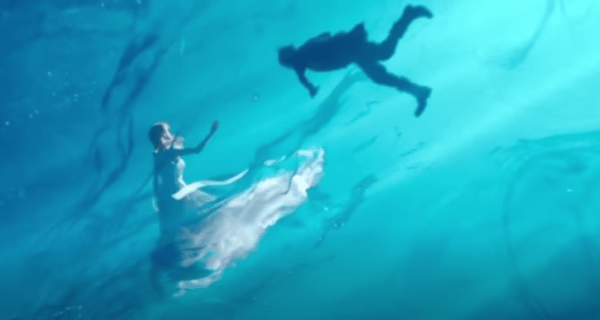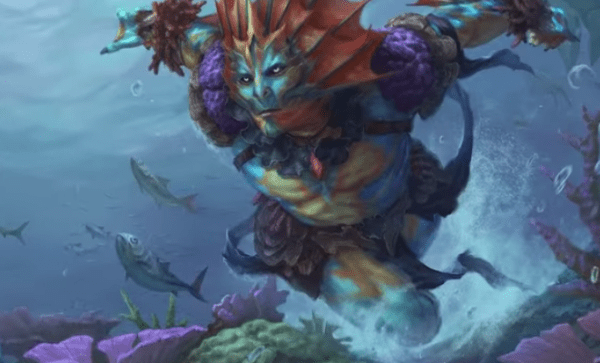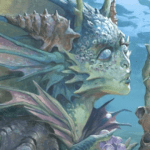The swaying of a ship at sea might not be for everyone. Just as being inside the mouth of a sea creature might have some wanting to curl up into a ball and never see the light of day… and yet, here we are. This is the life of an adventurer at sea- where the sea is salty as the insides of a fish are smelly.
What Should I Expect in Sea Encounters 5e?
Debatably the most difficult types of encounters for DMs and players alike. There are many resources online and given through the Dnd books for combat-based encounters. Despite that, setting up sea encounters to make sure it flows smoothly is, in my opinion, the most difficult part.
Are the players going to be on a boat? Are they in a secret cave underwater? Are they landbound near a beach? There are many things to consider when it comes to sea encounters.

Despite that, possibly the only simple thing about sea encounters is the possibility of monsters within them. As stated previously, there are a lot of resources for both maps and monsters for sea encounters, mainly combat-based. On top of that, most do fit the theme of being a sea encounter. They can be amphibious, sea or landbound, or even both. That being said, most sea encounters are pretty straightforward- it’s just a matter of the setting.
Tip: Make sure you read our guide on underwater combat!
Sea 5e Layouts
Although easier said than done, sea encounter layouts are extremely easy to think of and imagine. They may not be commonly used unless the encounters revolve around a specific quest or one-shot, but when executed correctly, the combat and roleplaying can be extremely dynamic. Many sea layouts can be integrated from other layouts, such as caves, swamps, and river/lake encounters.
Since you would find most of these encounters within a body of water, no specific layout is needed unless the DM wants to have the players set up on an island, cave, or boat. However, a good way to set up these encounters has a certain layout, like having the party teleported to a small island where they have to fight a sea monster. It may be repetitive, but sea encounters are, once again, extremely conditional.

Ships and Boats
Naturally, one of the first layouts that should come to mind regarding sea encounters would be ships and/or boats. Any player and DM can imagine setting out on an adventure as a pirate to an unknown land via boat. They would need to ensure not to have their transportation destroyed and damaged while protecting themselves simultaneously. The sense of danger and being stranded at sea escalate the urgency for being careful with the players, which can either go really well or badly, depending on what kind of players a DM has.
If there will be critical damage to the ship, ensure that the damages’ urgency is emphasized once they happen. This can be used when the party seems to take down the creatures too quickly. For example, if the party is fighting a giant octopus and the encounter seems to be going too quickly, have the shark take a huge bite of a section of the boat, causing the boat to sink at an alarming rate.
Open Sea Encounters 5e
1. Band of pirates
A small band of pirates ambushes the party’s ship, demanding any valuables and treasures. Unfortunately, there is no negotiating with them, and the party has to fight them if they want the pirates to leave them alone.
2. Siren’s
The current begins to get more and more dangerous, shifting the ship in every which direction. However, some people on board are paying no mind to the danger. When a player goes to see why it seems that the person is in a trance, they begin to hear an alluring song that makes them want to just… lie down and enjoy the moment… (it’s a siren’s song).
3. Storm
A storm is in the distance, but it seems to be only in a small specific area. Regardless, it’s coming straight for the boat and follows it no matter how they try to steer it.

Deserted Island
In short, a deserted island that can be optimized for sea encounters is usually just a small patch of land. It can have minimal space and foliage, with the sea simply surrounding it. I find it fun when the party is forced to fight with limited space just so it could be easier for me to manage and the monsters have more space to move around.
With this layout, the DM also has the option to integrate different sorts of environments and encounters (caves, mountains, forests, jungles, swamps, etc.). However, since it is a deserted island, limiting the environment to one (excluding the beach area) would be best. A deserted island should be small and manageable rather than it being its continent, after all.
Below are some deserted island encounters I have tested and/or plan to use one day.
Deserted Island encounter ideas for 5e
1. After shipwreck
The party wakes up on an island after a terrible shipwreck. The island is extremely tiny to the point where they can easily walk from one end to the other. A large family of hungry sharks is circling the island, waiting for the party to take a swim…
2. memory loss
The party wakes up on an island without remembering how they got there. There seem to be several other islands in the distance, but first, they’ll need to cross the mysterious body of water that’s… glowing (it’s a swarm of glowing jellyfish)
3. Whale VS octopus
After days of traveling, the party has finally found the ocean- marking the end of the island. They have all the resources for the boat, so all they have to do is build it and leave this place once and for all. It should be simple enough… if there wasn’t a family of angry whales fighting a giant octopus in their way.

Secret Underwater Things
The most magical and lore building of the layouts is hidden under the bodies of water. Unless the main setting and/or characters are meant to be underwater, underwater secrets can be fulfilling as they can be dangerous.
Since most underwater secrets are meant to be hidden, there should be a handful of dangerous encounters to protect the secret(s). That being said, ensure not to abuse these layouts too much and keep them to a minimum. Otherwise, the players might constantly expect to find secrets in the water and waste a lot of essential time.
Layouts like these can be integrated with other layouts, such as temples, caves, or even a city (these are the most common types of layouts for underwater secrets). Although they can be diverse, it is best to ensure that the secrets are kept to only one layout. For example, you shouldn’t put a secret temple or cave in the same area and session. If it does happen, it could take away the shock factor and make the players desensitized to the encounters.
Below are a few encounters I like to use and have created for past sessions.
1. Underwater Cave
Deep inside a well is an underwater cave home to a sea witch who likes to make shady deals with anyone who passes through. If they provoke her in any way, the cave’s creatures will aid her.
2. Temple on the Beach
As the party roams on the beach, they notice a temple in the distance. It doesn’t seem to be on any sort of land… but it’s so tall that the top is peaking from the ocean despite submerging. The entrance to this temple lies at the bottom of the sea.
3. Greedy thieves
After almost drowning at sea, a band of merfolk saved the party by bringing them to their underwater utopia. Soon after they arrive, though, the party discovers that they are followed by greedy thieves and smugglers who want to take the merfolk of all their resources.
Types of Sea Encounters 5e
Unlike most encounters, sea encounters come pretty easily with a theme- aquatic creatures. It doesn’t exclusively have to be aquatic creatures, but you’ll rarely find anything else when it comes to sea encounters.
Sea encounters can be extremely difficult for players, especially when the creature is bound to a body of water, which, for most people, it makes it more fun since it’s a different type of encounter they have to work their way around.
Despite aquatic creatures being very rarely used, the DnD books and online community have a plethora of sea encounters and creatures made. Unless you want to create a sense of urgency or danger, most of these creatures should be encountered on the deeper end of a body of water rather than the shallow end.
For example, it wouldn’t make much sense for a whale to be at the shallow end of an island unless it was put there for a specific encounter that would somehow progress the story.
As stated before, non-combat encounters are a little more difficult to implement since aquatic creatures are usually neutral or hostile- making combat-based encounters much easier to think of.
That being said, if you are a newer DM or just want to think of a quick encounter, it would probably be best to stick with a basic combat encounter to make things interesting and fun. But, of course, with sea encounters, don’t be afraid to add more monsters that are non-aquatic. Maybe something with wings or magic also wants to join in on the fight!

My Favorite Sea Encounters!
I have thought of, planned, and/or used most of these myself. Regardless, I will credit where I got the inspiration from if any was used. Otherwise, be free to take inspiration from these ideas for yourself! My players had much fun getting around the scene or getting through it together. Make sure to alter it to what your players will enjoy so every experience is different.
Once again, below are some encounters I made or found interesting enough to implement into my sessions. Enjoy!
1. Ghost Ship
The party has somehow come across a thick fog while sailing. That’s when, through the fog, comes a spectral ghost ship. Aboard are undead crew who want nothing more than live a life of stealing treasures from the living.
2. The Island is Alive
After being on this island for what seems like forever, the party is tired of looking for this “gigantic monster” on this small island. Little do they know that the island is the monster they’re looking for.., (it’s a dragon turtle).
3. Summon The Giant
After a long drought, the kingdom decided to summon a Storm Giant in hopes that it would bring the kingdom water. However, it turned against them when the Storm Giant created a great storm that flooded almost the entire kingdom. To stop the flooding, the Storm Giant must be killed.
4. A… Swarm?
To relax, the party decided to bask in the view of the ocean on a cliff. But, unfortunately, those calm moments become rudely interrupted when they see… a swarm of angry seagulls coming straight to them?
5. Best Catch
A fishing competition has been announced inside a small village. Whoever catches the most fish (in weight) will be rewarded with a feast and enough gold to buy a castle. The only catch? Most of the professionals are psychopathic druids with the ability to shapeshift and hunt in the waters.
Fishy and Dangerous (List)
Many of these creatures are almost a must-do-at-least-once regarding sea encounters. Not only are they super fun to do and set up, but they are extremely manageable (especially if you control more than one of the creatures during combat). Most of them are also strong enough to be mini-bosses or regular bosses, but when it comes to sea encounters, I feel like there should always be at least one sea monster to rule them all per adventure. Now, have a splash!
- Kraken: ah, yes. The classic sea monster can strike fear with just its massive size alone. The Kraken is considered a Titan, which means one thing only for a DM- don’t be afraid to break some bones, limbs, and/or lives with this. It’s meant to be ruthless and extremely powerful, especially if the players have decided to tick it off or wander into its lair. They will have difficulty killing this thing because there are so many ways that things can go wrong.
- Water Elemental: would a large body of water be a lot of fun without a water elemental? It can be if you’re into a boring, peaceful life. However, in the life of Dnd, it’s only normal to have a few mobs here and there that will try to drown you in their own body. Psssst, check out our Earth Elemental guide!
- Dragon Turtle: Usually mistaken for an island, Dragon turtles keep to themselves and float however and wherever they please. I imagine that it also may act as a guardian for the creatures that live on top of its shell, so it’s possible to anger it if mortals decide to mess with the home it has made. Although it does hit like a truck, the combat for the dragon turtle is pretty straightforward for a massive monster.
- Storm Giant: I think of Storm Giants as somewhere between Thor and Hercules regarding roleplaying and combat style. They know how to use magic, they know to fight, and they will do whatever they think is right. That said, I feel like they are the “hit first, think later” kind of people (or giants? Giants can be considered people, right?). They can strategize in battle, but it may take a little beating for them to figure out that they should be using their brains.
- Giant Shark: Practically a staple sea monster for low-leveled and high-leveled parties. It’s big enough to take down ships (no swallow whole, though) and is known to be chaotic evil for the most part. Almost always hungry, it will strike at anything and everything without thought or remorse. Make sure to leave it in the deeper parts of the ocean, though. If the party ever mistakes it for just a simple shark, it could be the last thing they do. So make sure you have a wall of water 5e ready!
Conclusion on most fun sea encounters in 5e
Setting up a sea encounter isn’t exactly a walk in the park, but playing out the encounter is possibly the easiest and best part of the experience. The creature could dive back into the water and reposition, leaving the party guessing where it could strike next.
I feel like every campaign should at least have one sea encounter, just as any show should have a filler episode (or a beach episode, if you watch anime) just to have them relax for a bit… only for the DM to just remind them that they are always in danger.
